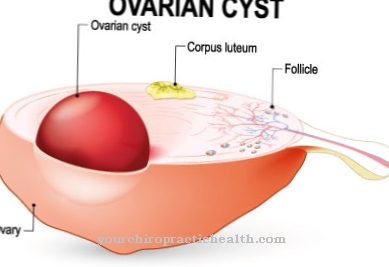Under Metastases one always understands a so-called daughter lump of a tumor or a tumor-like tissue. As a rule, this daughter tumor is always outside the part of the affected person's body that was already or originally affected.
What are metastases?

© designua - stock.adobe.com
Metastases are only formed by the malignant tumors. During the process of metastasis, the diseased or degenerated cells split off.
These split off cells get into the bloodstream of those affected and are thus transported to the different places in the human body, where they again attach themselves to tissue areas. The split-off tumor cells can also be distributed via the lymph.
However, the size of an existing tumor has nothing to do with its actual formation of metastases, because when breast cancer is diagnosed, for example, even very small tumors less than one centimeter can metastasize.
causes
As causes of Metastases present malignant tumors are called. A metastasis is always meant with the so-called spread of existing tumors to other parts of the body. If an existing cancer is diagnosed at an advanced stage, metastases are also present. In this case the chances of recovery are already reduced.
The exact mechanism and the associated causes of metastases are not yet fully understood, because cancer cells grow in the human body in an uncontrolled manner. Cell division is a very important fact here, because during the division of the cells the connection with the surrounding tissue is interrupted for a very short time. During this short period of time, the degenerated cells can move through the lymph and bloodstream. The lymph nodes are very often affected because they filter out the tumor cells.
Basically, the cause of metastases can be noted that there must always be a malignant tumor; only then can the metastases gradually become embedded in the surrounding tissue. However, the metastasis essentially depends on the type of tumor and the origin of the disease in question in the patient concerned.
Symptoms, ailments & signs
Metastases are the advanced forms of cancer. It can take different forms, as the symptoms depend on where on the body metastasized. Some metastases are already visible externally.
In addition to the skin metastases on the surface of the skin, this also applies in particular to metastases to the lymph nodes, which are usually enlarged and often palpable when infected. Typical areas for this are the groin, armpit, collarbone and the sides of the neck.
Other metastases, on the other hand, are noticeable in the functional limitations of internal organs. Lung metastases can lead to shortness of breath and blood in the sputum. Various symptoms cause brain metastases. Depending on where they are, they can cause memory disorders or language problems, dizziness or fainting, and failures in other parts of the body such as the legs and fingers. Metastases to the liver are often noticeable as yellowing of the skin and tiredness.
Since metastases are signs of a progressive cancer disease, they are often recognizable by a clearly restricted resilience. Often patients are also noticeably pale. This is usually the cause of the anemia that accompanies many cancers. This is especially the case when there are metastases in the spinal cord area, where blood formation for the body takes place.
Complications
Metastases are already a serious complication of cancer. Their wandering in the body, depending on their amount and branches, leads to other serious complications. In principle, all areas of the body that are connected to the lymphatic and circulatory system can be attacked by metastases.
Crossing the blood-brain barrier is possible. Correspondingly, the complications caused by spreading tumors are numerous. When tumors metastasize, a particular risk is posed by diffuse carcinosis. Such a condition means that an organ or tissue is affected by cancer cells in a disorderly manner, which makes an operation considerably more difficult due to the lack of a primary tumor.
Removal of entire organs or recurring tumors are often required, as is chemotherapy. Metastases in the brain are also particularly dangerous because they are difficult to operate and lead to massive impairments. A large number of metastases in the brain correlates - depending on their location - with a very high death rate.
In addition, an already metastasizing tumor can spread its metastases so far that small accumulations of cancer cells can be overlooked. It is possible, for example, that years after the cancer has been treated, further tumors will be found as a result of the earlier metastasis.
All other complications of metastases are congruent with those of cancer. Once metastases have spread, complete treatment of the cancer is often difficult or even impossible.
When should you go to the doctor?
Metastases develop in the late stages of cancer and are an urgent reason to see a doctor. Most of the time, the patient doesn't even think about cancer or metastases, but only now notices the first symptoms. Some cancers are so tricky and difficult to notice that the patient only realizes that something is wrong when the metastases spread. Cancer patients with a known diagnosis, on the other hand, should consult their treating oncologist as to how they might notice that metastases are forming. Depending on the type of cancer and the affected area of the body, a simple regular palpation can be enough to detect changes such as new tumors at an early stage.
If nothing can be seen or felt, but the symptoms of cancer have changed, the attending physician must also investigate. Even if they have gotten better, the doctor must know that. From a certain age, regular preventive examinations can be attended and examinations can be carried out independently at home. At best, of course, cancer is recognized before it has even metastasized. These examinations should be performed and carried out regularly, because the earlier possible metastases are detected, the better the prognosis for the patient. In addition, check-up appointments are covered by the health insurance companies after reaching a certain age.
Treatment & Therapy
For the treatment of Metastases There are different options for treatment, because they can be treated by surgery as well as chemotherapy and drug measures.
When treating the metastases, the location of the daughter tumors is of course also important, depending on which an operation or other measures are used. A standard therapy for metastases, especially bone metastases, is the administration of bisphosphonates.
These are special drugs that allow an increased incorporation of minerals and calcium into the bones. As a result, the bone loss caused by the existing tumor can be reduced and the regeneration of the already attacked bone parts can begin.
Outlook & forecast
The formation of metastases is usually synonymous with a negative prognosis. They are the most common cause of death in cancer patients. If a tumor has not yet spread, the treatment is far more promising. In principle, medical science today is able to decelerate the further development of metastases. In the majority of diseases, however, a final cure is ruled out. This requires the complete removal of all tumors.
The remaining years of life are significantly reduced when the metastases have formed on vital organs. Lung involvement, for example, is considered extremely unfavorable. Only every second patient survives the fifth year of life. The spread also plays a role. If the number of tumors gets out of hand, chemotherapy is usually the only option.
In principle, abstaining from nicotine and alcohol as well as a healthy diet in the decade before the prognosis improves the chances of success. If all metastases and the original tumor were successfully removed, the patient must still expect a limited life expectancy. Experience has shown that new tumors form in a large number of cases. Therefore, aftercare plays an important role.
prevention
Basically, it should be noted here that after a cancer diagnosis, certain measures are always taken to avoid metastasis or relapse.
However, no one can predict this, but the affected patients should make sure that the follow-up examinations should take place as soon as possible. This is the only way to ensure that metastasis cannot develop again.
In addition to the general medical internships, alternative healing methods should also be used. However, this should be discussed with the responsible oncologist, because you should only surround yourself with approved and experienced alternative practitioners in order to be able to record explicit successes.
Aftercare
The actual cancer treatment is followed by aftercare. The patients are cared for individually. Tumor follow-up care is an important part of cancer therapy. One of the most important goals of tumor follow-up care is the timely detection of a new tumor or metastases (daughter tumors) in other parts of the body.
With an early diagnosis, appropriate treatment measures can be initiated immediately before symptoms set in. The patient's quality of life also plays an important role in cancer follow-up care. It is important to clarify what consequences the disease or its therapy has on the everyday life of the person concerned. The therapists also support the patients in coping with the serious illness.
If necessary, they can establish contact with different contact persons; sometimes contact with self-help groups can help to balance the emotional balance by realizing that you are not alone with your suffering. Depending on the type, extent and treatment of the tumor, the doctor will create an individual aftercare plan.
It is not uncommon for there to be a smooth transition between metastasis therapy, progress monitoring and follow-up care. The duration of the follow-up treatment depends on how long the patient has been suffering from the effects of the tumor disease and when the risk of relapse has decreased. Usually five years are estimated for this.
In addition to the type of cancer, the side effects and long-term effects of illness and treatment as well as the individual course of the cancer are important for follow-up care.
You can do that yourself
The regression of metastases is considered unlikely in a large number of patients. In most cases, the metastases can only be removed through surgery. Nevertheless, some sick people have repeatedly reported for years that they were able to improve their health situation after changing their way of life. This also includes the regression of metastases.
A balanced diet rich in vitamins is particularly helpful, although there are insufficient statistical findings for effectiveness. The information and tips from different providers should therefore be checked individually. However, medical professionals agree that there are various foods that are beneficial for recovery from cancer. A sugar-free food or fruit juices are among them. In addition, there are dietary supplements that are offered for maintaining good health.
In addition to a healthy diet, sufficient exercise and light sporting activities support general well-being. Consumption of harmful substances such as nicotine or alcohol should be avoided completely. Getting enough sleep, avoiding unnecessary stress, and various relaxation techniques are also recommended with great success. In some cases, sick people experience an improvement in their health when they practice yoga, autogenic training or meditation. The stabilization of the mental abilities helps in dealing with the current situation.


.jpg)

.jpg)

.jpg)

















.jpg)



